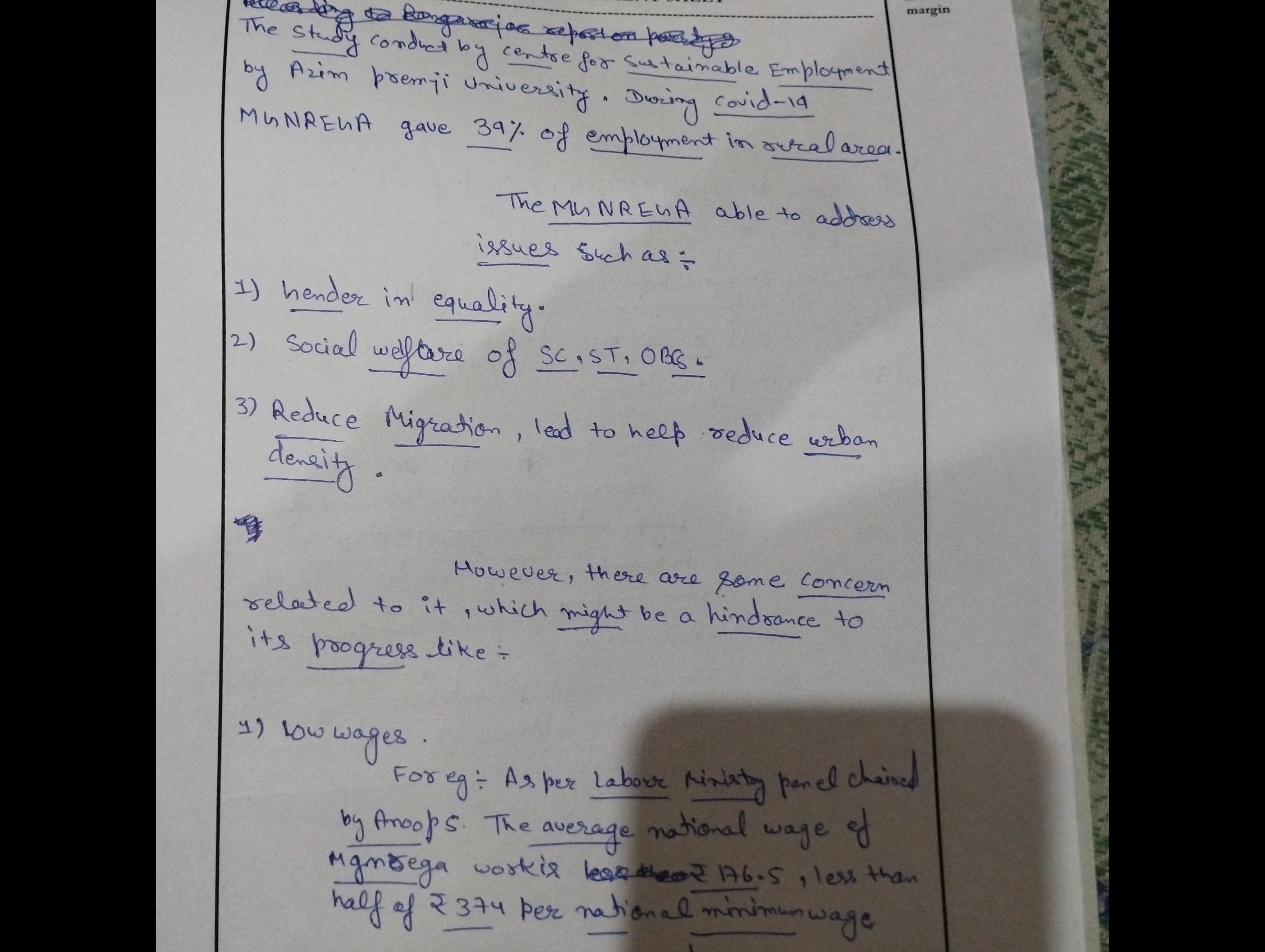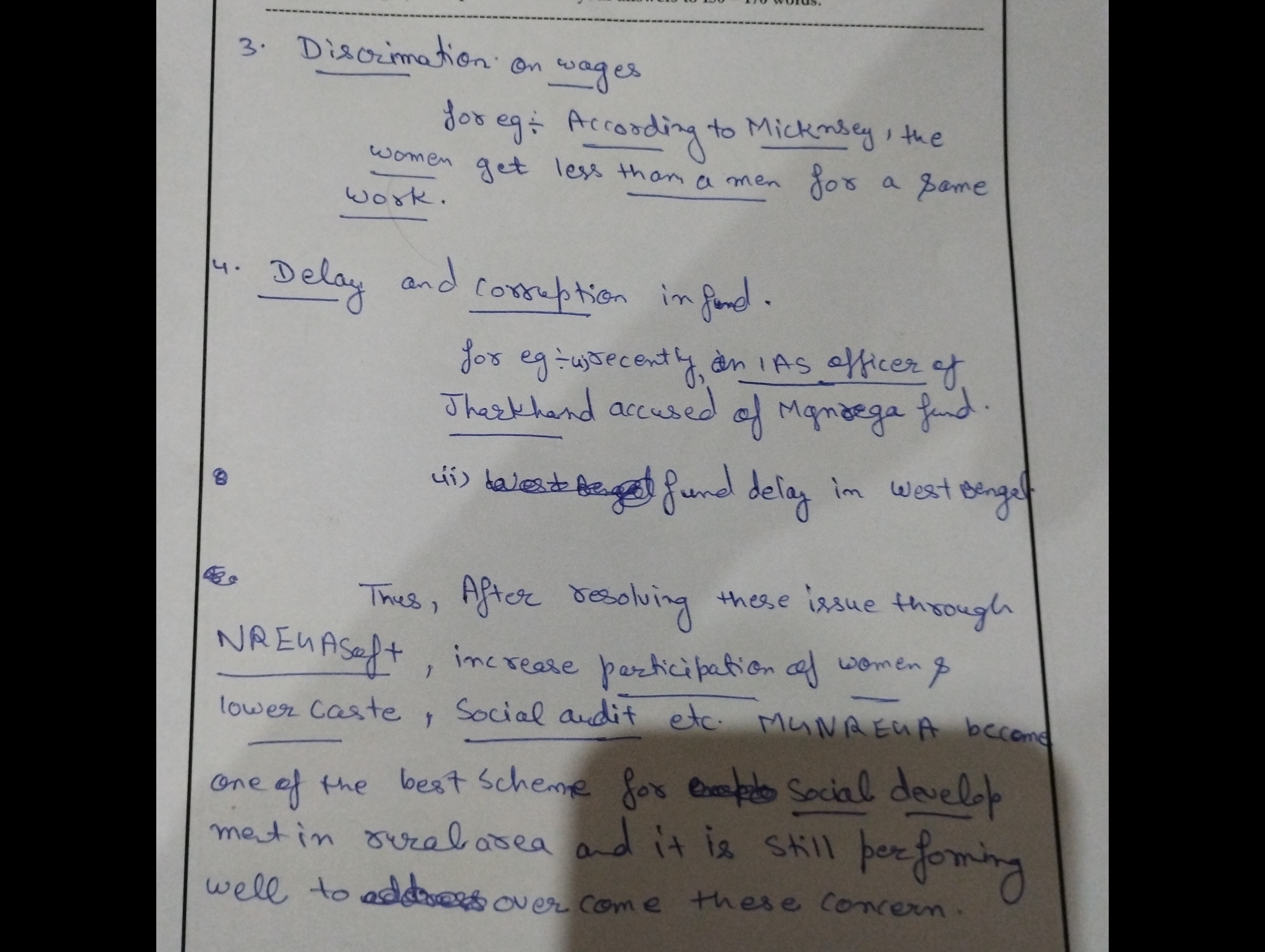| Demand of the question Introduction. Contextual introduction. Body. Discuss progress made under MGNREGA. Mention various issues related to it. Conclusion. Way forward. |
The Mahatma Gandhi National Rural Employment Guarantee Act (MGNREGA) guarantees 100 days of work a year to every rural household with an aim to enhance the livelihood security of people. It is the only employment guarantee program run by the government. Considered as one of the biggest social welfare programmes in the world the programme has lifted lakhs of people out of poverty, though many lacunas still exist in it.
MGNREGA scheme success in addressing rural distress: MGNREGA scheme has been able to address the issue of rural distress to some extent:
- Employment: MGNREGA is the biggest single public works programme in the world. According to the World Bank, it provides employment to around one in every six Indian families. Last year, about 235 crore person-days of work were generated under the scheme. The Act for the first time brings the role of the state as provider of livelihood which has led to economic emancipation of rural people from distress.
- Financial inclusion: The programme has led to empowerment of the rural poor and led to financial inclusion due to rise in rural wages and prevention of urban migration. Payment through bank accounts has led to financial inclusion of many.
- Women empowerment: Out of the total jobs created so far, the percentage of hours put in by women has increased steadily, much above the statutory minimum of 33% to 57%. There are three provisions in the MGNREGA that were specifically included into the act to ensure access to the benefits to rural women:
- Priority for women in the ratio of 1/3rd of total workers employed.
- Equal wages for men and women.
- Crèches for the children of women workers.
This has helped in economic empowerment of women and thus led to overall welfare of women.
- Empowerment of marginal section: According to the Rural Development Ministry, out of all the workers benefited under the scheme, the percentage of Scheduled Caste workers has consistently been about 20% and of Scheduled Tribe workers has been about 17%. Due to this their condition has improved leading to their upliftment.
- Rural transformation: MGNREGA is said to have changed the face of whole rural labour and rural India. In places where it was effectively implemented, it empowered people, and in places where it was not implemented effectively, it gave powers to labourers to demand higher wages. It has given dignity to them and has acted as a market mechanism.
Issues with MGNREGA:
- Delay in wages: The Union Ministry of Rural Development withholds wage payments for workers of states that do not meet administrative requirements within the stipulated time period. For instance, delay in submission of the previous financial year’s audited fund statements, utilisation certificates, bank reconciliation certificates etc. lead to delay in wage payments. This delay in processing and payments of wages is not compensated properly.
- Low wage rate: Currently, MGNREGA wage rates of many states are less than the corresponding state minimum wages. Various judgements have upheld that the MGNREGA wage rate cannot be less than the minimum agricultural wage rate of the state. The low wage rates have resulted in lack of interest among workers in working for MGNREGA schemes, making way for contractors and middle men to take control locally.
- Funding: MGNREGA’s success at the ground level is subject to proper and uninterrupted fund flow to the states. Almost every year, more than 80% of funds get exhausted within the first 6 months. This year’s budget allocation for the scheme was only ₹60,000 crore, lower than the amount spent in the previous year. Thus, fund allocation is insufficient to ensure proper implementation on the ground.
- Capital formation: Successive governments have spent an estimated 3.1 trillion on MGNREGA schemes over the past decade. The impact of such spending would have been far higher if the money had been used for rural infrastructure that would have raised productivity as well as helped the structural transformation of the rural economy.
- Inflation: MGNREGA pushed up rural wages without having much of an impact on rural productivity. It led to inflation as nominal wages rose faster than productivity. This has hit the poor the hardest.
Way forward:
- Adequate funds: The government needs to allocate funds to ensure adequate opportunities for these households. Allocation for a year should include pending liabilities of previous years. The Centre also needs to ensure uninterrupted operations by primarily ensuring the allocation of adequate funds for the programme.
- Timely payment: The government should ensure timely payment with reduced delays. Also, the MGNREGA payment procedures should be simplified to ensure transparency and accountability.
- Increasing wage rates: Wages must be increased to ensure benefit of the poor. More income means more economic empowerment of rural poor. This will enable social welfare in the form of increased spending on health and education.
It is important to substantially increase the budget for programmes such as MGNREGA. This would lead to higher disposable income for the poor and have positive multiplier effects in the economy.Timely payment of wages and an increase in wage would help many rural people to come out of distress.







